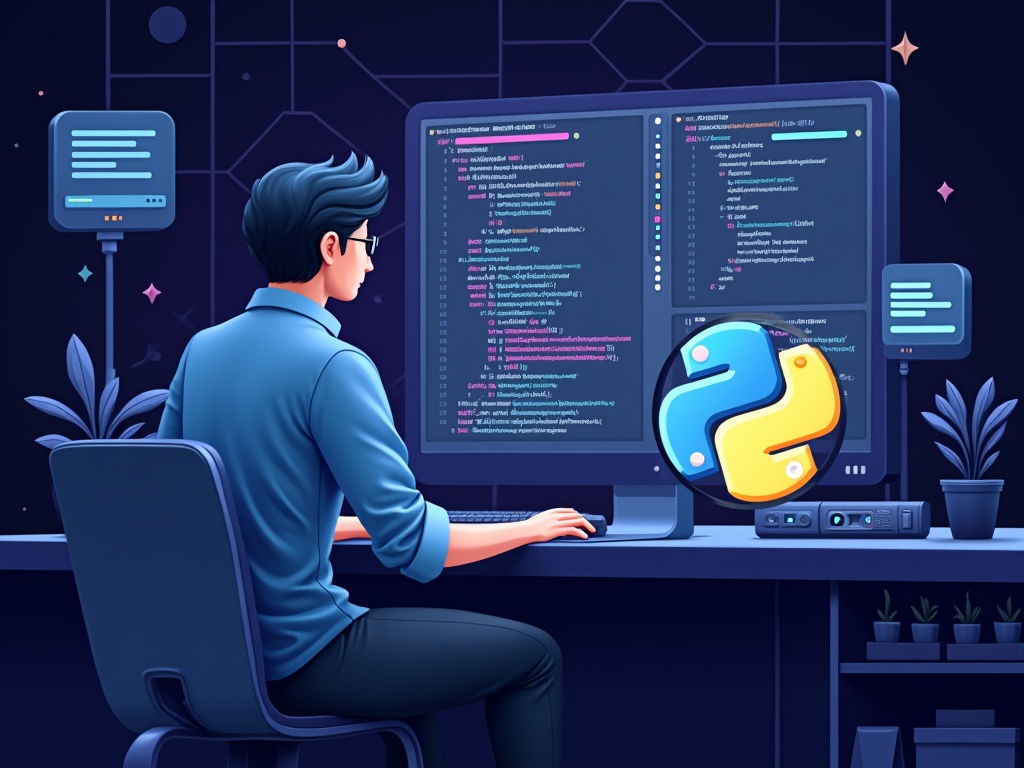1. What is Python?
Python is a high-level, interpreted programming language known for its simplicity and readability. It is widely used across different domains, including web development, data science, artificial intelligence, automation, and more. Python supports multiple programming paradigms such as procedural, object-oriented, and functional programming. Due to its vast ecosystem of libraries and frameworks, Python has become one of the most popular languages among developers and data scientists.
2. What are the key features of Python?
Python offers several key features that make it a preferred choice for developers:
- Easy to Learn and Use: Python has a simple and clean syntax, making it beginner-friendly.
- Interpreted Language: Python executes code line by line, which simplifies debugging.
- Dynamically Typed: Variable types are assigned during runtime, making the code more flexible.
- Extensive Libraries: Python provides numerous built-in libraries and frameworks for various applications, such as NumPy, Pandas, TensorFlow, Flask, and Django.
- Portability: Python code can run on different platforms, including Windows, macOS, and Linux, with minimal modifications.
- Garbage Collection: Python has an automatic memory management system that handles object deallocation.
3. What is the difference between lists and tuples in Python?
Lists and tuples are both sequence data types in Python, but they have distinct differences:
| Feature | List | Tuple |
|---|---|---|
| Mutability | Mutable (can be changed) | Immutable (cannot be changed) |
| Syntax | Defined using square brackets [] |
Defined using parentheses () |
| Performance | Slower due to dynamic allocation | Faster as it has fixed size |
| Memory Consumption | More memory required | Less memory consumption |
Example:
# List
my_list = [1, 2, 3]
my_list[0] = 10 # This works
# Tuple
my_tuple = (1, 2, 3)
my_tuple[0] = 10 # This will raise an error
4. Explain the concept of functions in Python.
Functions in Python are reusable blocks of code designed to perform specific tasks. They help in modularizing code and improving reusability.
Syntax:
def add(a, b):
return a + b
result = add(5, 3) # Output: 8
Functions can also take default arguments, return multiple values, and support variable-length arguments using *args and **kwargs.
5. What is PEP 8?
PEP 8 is the official Style Guide for Python Code. It provides a set of conventions for writing more readable and maintainable Python code. Some key aspects include:
- Using four spaces per indentation level
- Limiting line length to 79 characters
- Using meaningful variable and function names
- Keeping imports at the top of the script
6. How does memory management work in Python?
Python handles memory management through:
- Private Heap Space: All Python objects and data structures are stored in a private heap.
- Reference Counting: Python keeps track of object references, and when an object has zero references, it is removed from memory.
- Garbage Collection: Python has an automatic garbage collector that removes unused objects to free up memory.
7. What is the difference between shallow copy and deep copy?
A shallow copy creates a new object but inserts references to the objects found in the original. Changes to mutable objects in the original reflect in the shallow copy. A deep copy creates a completely independent copy of the original object, ensuring that changes in the original do not affect the copy.
Example:
import copy
# Original List
original_list = [[1, 2, 3], [4, 5, 6]]
# Shallow Copy
shallow_copy = copy.copy(original_list)
# Deep Copy
deep_copy = copy.deepcopy(original_list)
8. How do you handle exceptions in Python?
Exceptions in Python are handled using try, except, else, and finally blocks.
Example:
try:
x = 1 / 0
except ZeroDivisionError:
print("Division by zero is not allowed!")
finally:
print("This block always executes.")
9. What are decorators in Python?
Decorators are special functions that modify or enhance other functions or methods without changing their actual code. They are widely used in logging, authorization, caching, and more.
Example:
def decorator_function(original_function):
def wrapper_function():
print("Wrapper executed before {}".format(original_function.__name__))
return original_function()
return wrapper_function
@decorator_function
def display():
print("Display function executed.")
display()
10. Explain list comprehensions in Python.
List comprehensions provide a concise way to create lists by iterating over an iterable and applying an expression to each item. They are more readable and faster than traditional loops.
Example:
squares = [x**2 for x in range(10)]
print(squares) # Output: [0, 1, 4, 9, 16, 25, 36, 49, 64, 81]
These Python interview questions cover a broad range of topics that can help candidates prepare effectively for their technical interviews. From understanding basic syntax to advanced topics like decorators and memory management, this guide provides essential knowledge to build a strong foundation in Python programming.
📥 Download SQL Handwritten Notes – Master SQL concepts with easy-to-understand handwritten notes.
🔗 [Click Here]

